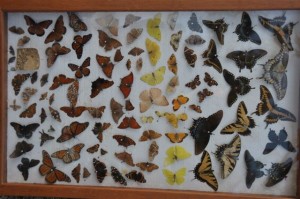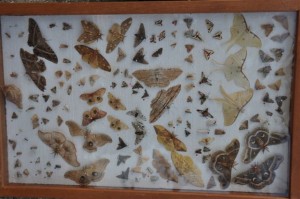Keith Kridler Mt. Pleasant, Texas When you sit out and enjoy your daffodil beds or fields of daffodils between collecting blooms and racing off to haul them to shows you will often see all sorts of species of insects that are attracted to either the pollen or the nectar of these blooms.
Our local Game Warden collects insects as a hobby and he ONLY collects these from within about 20 miles of Mt. Pleasant here in the northeast corner of Texas.
Notice all of the species of the Hawk or Sphinx Moths and notice “maybe” in these smaller photo sizes the length of the tongue or “drinking straws” of the larger species that he has stretched out.
One of the problems with the various Jonquil and poeticus species or their hybrids are that the throat of these blooms will prevent short tongued insects from getting the rewards of the nectar down at the base of the anthers or pistil. This limits pollination to insects that are attracted just to the easy to reach pollen or to insects with a longer “drinking straw”. These normal have three anthers easy to reach by any insect and then three more anthers deep down that deposit their pollen on the insect drinking straws as they slide through the ripe pollen. Then this pollen gets deposited on the pistil of the next bloom that they visit.
MANY species of tiny solitary bees will gather pollen from jonquils as will the European Honey bees. The more blooms you have of the same species of plant the more pollinators that will begin to show up day after day or night after night as long as these plants continue to bloom.
So far they have identified more than 350 different species of solitary bees just in the eastern half of Texas that gather pollen to feed to their larva.
Again these photo are just the most colorful moths and butterflies that Jerry Ash has collected to show to local school children. MOST of the local species of moths are pretty drab looking and for every species of butterfly in the state of Texas they estimate that their are six species of moths.
These are the larger species, then there are “macro” sized species and they estimate there are more than 4 “macro” sized moth and butterfly species for each of the “larger” species. Then there are MANY more times “micro” species of butterflies and moths than there are Macro species….
Interesting that the daffodil breeders name their flowers for birds, people, places, islands, colors or shades of colors..
Lordy but I would pay dearly for a solid light green daffodil, named “Luna Moth”. Why did someone name a solid white daffodil “Bluebird”? I can’t wait to watch a daffodil named “Pucker Power” get auctioned off at an ADS national bulb auction. It is sure a LOT of fun watching some of these expensive bulbs get auctioned off and as the prices go higher and higher you see some of the bidders really start to get tight lipped and “Pucker up” something fierce as the price gets out of reach or is that “reason”:-)) KK



